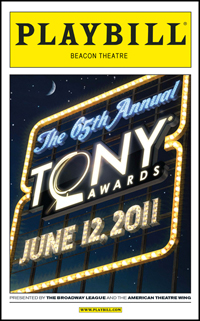
*
The first Tony Awards were held on Easter Sunday, April 6, 1947, at a 9 PM dinner dance in the Grand Ballroom of the Waldorf-Astoria with 1,200 members of the Broadway family attending. Tickets were $7.50, including tax.
An American Theatre Wing committee that Brock Pemberton formed decided that any memorial honoring the recently deceased Antoinette Perry should not be a structure or a monument "but take the form of annual awards that would be a living and self-renewing memorial." The awards were to be "by theatre people, for theatre people."
The ballroom was decorated as an homage to the Wing's Stage Door Canteen. The menu featured lobster bisque, salted nuts, breast of chicken Montmorency in black cherry sauce, croquettes of brown rice, asparagus tips Polonaise and frozen soufflé with strawberries. Entertainment was provided by the casts of such shows as Brigadoon, Call Me Mister, Carousel, Finian's Rainbow and Oklahoma!
At the stroke of midnight, over the Mutual Radio Network, 11 awards were presented. The first two years, there was no official Tony Award. The winners were presented with a scroll, cigarette lighter and articles of jewelry such as 14-carat gold compacts and bracelets for the women, and money clips for the men. Prizes were given to loyal attendees of first nights. There was even a special award honoring the long service of a particular stage doorman. Among the 1947 honorees were performers Ingrid Bergman, Helen Hayes, José Ferrer, Patricia Neal, Frederic March, and David Wayne; as well as Agnes DeMille and Michael Kidd for Dance Direction, Kurt Weill for Score (Street Scene), Arthur Miller as Outstanding Playwright (All My Sons) and Elia Kazan for Outstanding Direction (of the Miller play).
In 1949 United Scenic Artists sponsored a contest for a suitable model for the award. Scenic designer Herman Rosse had the winning entry, a three-inch silver medallion depicting the masks of comedy and tragedy surrounded by the words "Antoinette Perry Award" on one side; and on the other, within a laurel leaf crown, was a profile of Miss Perry.

Buy the 2011 Tony Awards Playbill |
The Wing authorized the League of New York Theatres (now The Broadway League) to co-present the Tonys in 1967. They were to be televised nationally, and so the event moved from the ballroom to a Broadway theatre.
Alexander H. Cohen, who was producing the show, suggested that the Award would look much better on TV if it were mounted. So, instead of the medallion being presented in a silk or velvet-lined case, it was designed to swivel and attached to a crescent-shaped armature. It was placed on a 3.75-inch black laminate pedestal, which made the full height eight inches.
For more than 25 years, the medallion has been manufactured by New York's Academy Engraving.
"The Tony is unique and quite distinct from other awards in that it has moving pieces," said Howard Sherman, executive director of the Wing. "The Tony remained essentially un-changed from 1967 until a redesign was made last year" by the League and the Wing.
The 2010 tweaks were made to the pedestal, not the medallion, Sherman said. "We increased the height of the pedestal by an additional inch and three-quarters [now 4.75 inches tall], and the base is now granite. So, the weight of the Award has increased significantly. It's now about two pounds heavier."
Broadway League executive director Charlotte St. Martin said, "As the medallion is such an important part of our branding of the Tony Awards, we felt it should have a more majestic look and feel. There's nothing like granite to convey substance, and importance."
Sherman pointed out that though there was never an intent to change the core design, there was a desire to make the Tony something the winner could hold more easily. "The new elongated pedestal is something one can wrap one's hand around," he explains. "By giving it weight and making it of more substantial material, the Award itself feels more substantial, as it should."
The irony, Sherman said, is that last year "we heard for the first time that the Award is really something to lug around."
Sixty-five years ago, "Tony" was a private word that acknowledged a tiny woman who never basked in the spotlight and who would do anything imaginable to benefit the theatre and its artists. It has now become part of the national vocabulary. From a radio broadcast, it has grown into a glittering and spectacular prime-time telecast that is aired in many countries.
*
Ellis Nassour is an international media journalist, and author of "Honky Tonk Angel: The Intimate Story of Patsy Kline."
This article appears in the Playbill for the 65th annual Tony Awards, June 12, 2011, at the Beacon Theatre on Manhattan's Upper West Side.










